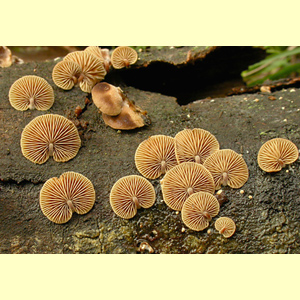
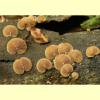
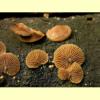
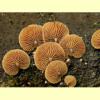
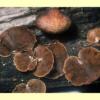
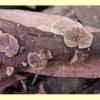
_AJ_35_sml.jpg)
Another species, Melanotus horizontalis, has been reported from Australia (as Naucoria or Phaeomarasmius), but according to Grgurinovic (1997), Cleland's records of this species are Gymnopilus tyallus. A report of M. horizontalis by Hilton & Clancy (1988), noted that it is 'similar to a miniature Gymnopilus... on burnt, fallen logs', but no voucher material was cited. The presence of M. horizontalis in Australia requires confirmation.
Recently, Melanotus has been merged with Psilocybe, which in turn has been split into two genera (Psilocybe for the blueing species and Deconica for the remainder). Melanotus hepatochrous most likely belongs in Deconica.
Grgurinovic, C.A. (1997a), Larger Fungi of South Australia. The Botanic Gardens of Adelaide and State Herbarium and The Flora and Fauna of South Australia Handbooks Committee, Adelaide. [Description and Microcharacters of M. hepatochrous]
Hilton, R.N. & Clancy, S. (1988), Larger Fungi of the Jarrah Forest. Conservation Council of Western Australia, Perth. [Report of Melanotus horizontalis (as Phaeomarasmius)]
Hood, I.A. (2003), An Introduction to Fungi on Wood in Queensland. University of New England, School of Environmental Sciences and Natural Resources Management, Armidale. [Description and B&W Illustration of M. hepatochrous]
Horak, E. (1977c), The genus Melanotus Pat., Persoonia 9: 305–327. [Description, B&W Illustration and Microcharacters of M. hepatochrous, along with Key to species of the genus worldwide]
McCann, I.R. (2003), Australian Fungi Illustrated. Macdown Productions, Vermont. [Illustration of M. hepatochrous]
